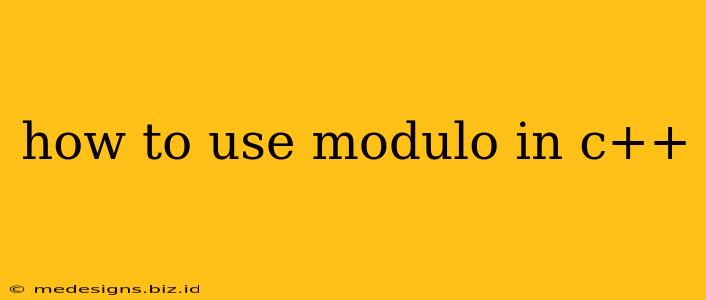The modulo operator, denoted by the percent sign (%), is a fundamental arithmetic operator in C++ used to find the remainder after division. Understanding how to use it effectively is crucial for various programming tasks, from basic number manipulation to more complex algorithms. This guide will walk you through the essentials of the modulo operator in C++, covering its syntax, applications, and potential pitfalls.
Understanding the Modulo Operator
The modulo operator returns the remainder when one integer is divided by another. For example:
10 % 3equals1(because 10 divided by 3 is 3 with a remainder of 1).15 % 5equals0(because 15 divided by 5 is 3 with a remainder of 0).7 % 2equals1(because 7 divided by 2 is 3 with a remainder of 1).
Important Note: The modulo operator only works with integers. Attempting to use it with floating-point numbers (like float or double) will result in a compiler error or unexpected behavior.
Syntax of the Modulo Operator
The syntax is straightforward:
int remainder = dividend % divisor;
Where:
dividendis the number being divided.divisoris the number you're dividing by.remainderstores the result of the modulo operation.
Practical Applications of the Modulo Operator
The modulo operator has a surprisingly wide range of applications in C++ programming:
1. Determining Even or Odd Numbers
One of the most common uses is checking if a number is even or odd:
#include <iostream>
int main() {
int number;
std::cout << "Enter an integer: ";
std::cin >> number;
if (number % 2 == 0) {
std::cout << number << " is even." << std::endl;
} else {
std::cout << number << " is odd." << std::endl;
}
return 0;
}
This code snippet checks if the remainder when the number is divided by 2 is 0. If it is, the number is even; otherwise, it's odd.
2. Generating Cyclic Sequences
The modulo operator is essential for creating sequences that repeat after a certain interval. For example, to cycle through an array of colors:
#include <iostream>
#include <string>
int main() {
std::string colors[] = {"red", "green", "blue"};
int numColors = sizeof(colors) / sizeof(colors[0]);
for (int i = 0; i < 10; i++) {
std::cout << "Color " << i + 1 << ": " << colors[i % numColors] << std::endl;
}
return 0;
}
This code will print the colors in a repeating sequence: red, green, blue, red, green, blue, and so on. The i % numColors ensures that the index wraps around to the beginning of the array when it reaches the end.
3. Checking Divisibility
You can use the modulo operator to check if one number is divisible by another:
#include <iostream>
int main() {
int num1, num2;
std::cout << "Enter two integers: ";
std::cin >> num1 >> num2;
if (num1 % num2 == 0) {
std::cout << num1 << " is divisible by " << num2 << std::endl;
} else {
std::cout << num1 << " is not divisible by " << num2 << std::endl;
}
return 0;
}
4. Extracting Digits from a Number
The modulo operator can be used to extract individual digits from an integer:
#include <iostream>
int main() {
int number = 12345;
int lastDigit = number % 10; // Extracts the last digit (5)
std::cout << "Last digit: " << lastDigit << std::endl;
return 0;
}
Potential Pitfalls
- Dividing by Zero: Dividing by zero using the modulo operator (or any division operation) will lead to undefined behavior and likely a program crash. Always check for a divisor of zero before performing the modulo operation.
- Negative Numbers: The behavior of the modulo operator with negative numbers can vary slightly depending on the compiler and implementation. It's crucial to understand your compiler's specific handling of negative numbers in modulo operations. Generally, the result will have the same sign as the divisor.
By understanding these aspects, you can effectively utilize the modulo operator in C++ to solve a wide variety of programming problems. Remember to always handle potential errors, such as division by zero, to ensure your code's robustness.
